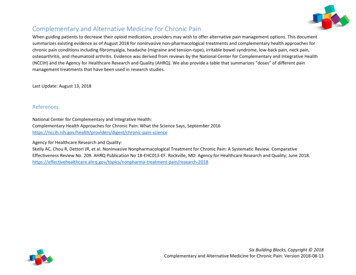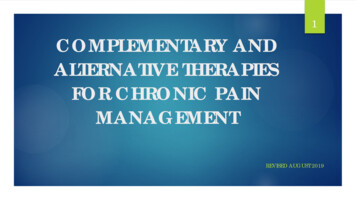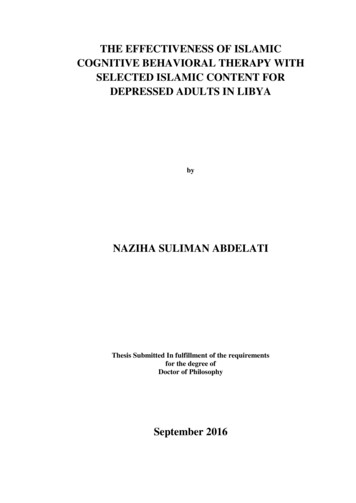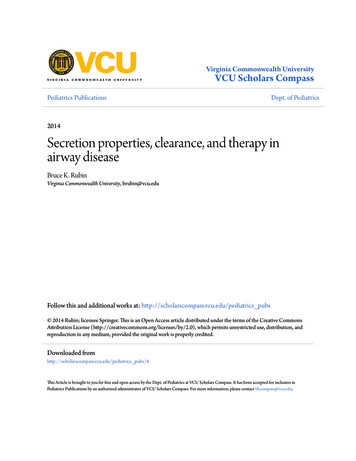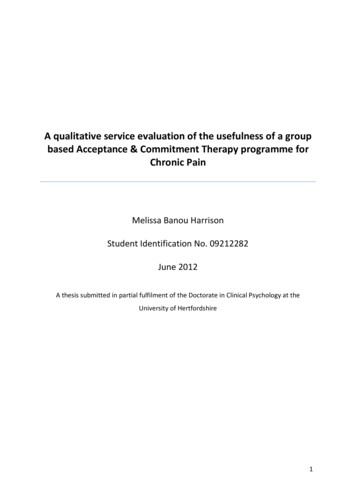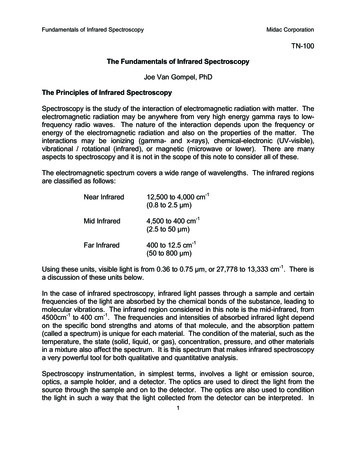
Transcription
gale 9577.qxd8/16/20063:00 PMPage 193ORIGINAL ARTICLEInfrared therapy for chronic low back pain:A randomized, controlled trialGeorge D Gale MBBS FRCA FRCPC DAAPM1, Peter J Rothbart MD FRCPC1, Ye Li2GD Gale, PJ Rothbart, Y Li. Infrared therapy for chronic lowback pain: A randomized, controlled trial. Pain Res Manage2006;11(3):193-196.OBJECTIVE: The objective of the present study was to assess thedegree of pain relief obtained by applying infrared (IR) energy to thelow back in patients with chronic, intractable low back pain.METHODS: Forty patients with chronic low back pain of over sixyears’ duration were recruited from patients attending the RothbartPain Management Clinic, North York, Ontario. They came from thepatient lists of three physicians at the clinic, and were randomlyassigned to IR therapy or placebo treatment. One patient dropped outof the placebo group; as a result, 21 patients received IR therapy and18 recieved placebo therapy. The IR therapy was provided by twosmall, portable units in a sturdy waistband powered by small,rechargeable batteries made by MSCT Infrared Wraps Inc (Canada).These units met safety standards for Food and Drug Administrationportability, and are registered with the Food and DrugAdministration as a therapeutic device. The unit converted electricity to IR energy at 800 nm to 1200 nm wavelength. The treated groupreceived IR therapy. The placebo group had identical units, but thepower was not connected to the circuit-board within the IR pad.Patients attended seven weekly sessions. One baseline and six weeklysets of values were recorded. The principle measure of outcome waspain rated on the numerical rating scale (NRS). The pain wasassessed overall, then rotating and bending in different directions.RESULTS: The mean NRS scores in the treatment group fell from6.9 of 10 to 3 of 10 at the end of the study. The mean NRS in theplacebo group fell from 7.4 of 10 to 6 of 10.CONCLUSION: The IR therapy unit used was demonstrated to beeffective in reducing chronic low back pain, and no adverse effectswere observed.Key Words: Chronic back pain; Infrared therapy; Low back pain;Lumbar painhe use of electricity for healing dates from 2750 BC, whenelectric eels were used to provide electric shocks (1).Magnetism from lodestones was also used by ancient people.Attempts to use electricity and magnetism in the 18th centurymet with little success. In 1975, Melzack (2) developed transcutaneous electrical stimulation (TENS) for prolonged painrelief. This provided 50% pain relief in 50% of patients in onestudy (3) but was no better than the placebo in another (4).Electrical and magnetic fields have been used successfully tostimulate bone repair (5) and soft tissue healing (6).Recently, infrared (IR) therapy has been developed, whichhas shown improved wound healing (7-9), relief of arthriticTLa thérapie à infrarouge pour les douleurslombaires chroniques : Un essai aléatoire etcontrôléOBJECTIF : La présente étude vise à évaluer le degré de soulagementdorsal apporté par l’application d’énergie infrarouge (IR) dans la régionlombaire de patients atteints d’une douleur lombaire chronique réfractaire.MÉTHODOLOGIE : Quarante patients atteints d’une douleur lombairechronique depuis plus de six ans ont été recrutés parmi les patients de laRothbart Pain Management Clinic de North York, en Ontario. Ils provenaientde la liste des patients de trois médecins de la clinique et ont été divisés demanière aléatoire entre la thérapie IR et un traitement placebo. Unpatient a quitté le groupe placebo. Par conséquent, 21 patients ont reçu lathérapie IR et 18, le traitement placebo. La thérapie IR a été administréeà l’aide de deux petites unités portatives placées sur une robuste ceinturealimentée par de petites piles rechargeables fabriquées par MSCT InfraredWraps Inc. (Canada). Ces unités respectaient les normes de sécurité deportabilité de la Food and Drug Administration (FDA) des États-Unis etsont enregistrées auprès de la FDA comme des dispositifs thérapeutiques.L’unité convertissait l’électricité en énergie IR selon une longueur d’ondesde 800 nm à 1 200 nm. Le groupe traité a reçu une thérapie IR. Le groupeplacebo a reçu des unités identiques, mais l’alimentation n’était pas reliéeau circuit imprimé du panneau IR. Les patients participaient à septséances hebdomadaires. Une série de valeurs a été enregistrée au départ,suivie de six hebdomadaires. La principale mesure d’issue a été cotée selonla douleur sur l’échelle d’évaluation numérique (ÉÉN). La douleur a étéévaluée dans l’ensemble, puis à la rotation et à la flexion dans différentesdirections.RÉSULTATS : Les indices moyens de l’ÉÉN du groupe traité ont chutéde 6,9 sur 10 à 3 sur 10 en fin d’étude. L’ÉÉN moyenne du groupe placeboest passée de 7,4 sur 10 à 6 sur 10.CONCLUSION : On a démontré que l’unité de thérapie IR utilisée étaitefficace pour réduire les douleurs lombaires chroniques, et aucun effetindésirable n’a été constaté.knee pain (10), increased endorphin levels (11) and bioactivation of neuromodulators (11-13).Because low back pain is the most common cause of musculoskeletal disability, it was decided to determine the effect ofIR on this condition using a new instrument developed byMSCT Infrared Wraps Inc (Canada).THE IR UNITThe IR unit developed by MSCT Infrared Wraps Inc is light,portable and designed to be worn on a belt. It is powered by asmall, rechargeable battery and is claimed to be 99% efficientin converting electricity to IR energy.1Rothbart Pain Management Clinic, North York; 2Department of Statistics, University of Toronto, Mississauga, OntarioCorrespondence and reprints: Dr GD Gale, Rothbart Pain Management Clinic, 5734 Yonge Street, Suite 300, North York, Ontario M2M 4E7.Telephone 416-512-6407, fax 416-512-6375, e-mail drgdgale@rothbart.comPain Res Manage Vol 11 No 3 Autumn 2006 2006 Pulsus Group Inc. All rights reserved193
gale 9577.qxd8/10/20061:59 PMPage 194Gale et alFigure 1) Infrared lower back pain wrap (MSCT Infrared Wraps Inc,Canada)It contains an IR-emitting element in a unique design withan IR grid and buzz bars down each side to deliver the electricity, converting it to IR energy at a wavelength of 800 nm to1200 nm.This instrument has met safety standards for portability andwas registered with the Food and Drug Administration as atherapeutic device in 2003. The unit used in the present study(Figure 1) contained two IR units and two batteries housed ina sturdy lumbar belt. The batteries require recharging every24 h and were then functional for 8 h to 10 h per day. The IRoutput was reliable at 800 nm to 1200 nm of wavelength, andthere was an automatic shut-off if the temperature rose to42 C. This feature was lacking in IR laser units, which therefore could cause thermal injury.THE POTENTIAL FOR ADVERSE EFFECTSThe continued use of heating devices in the past, some as simple as a hot water bottle, have caused the development of skinchanges known as erythema ab igne. Very thin individuals andthose with bony spurs have the potential to develop thermalinjury, but no injuries have been found during extensive testing of the MSCT unit on horses and human volunteers(S Wolfe, personal communication).METHODIt was decided to conduct a double-blind, placebo-controlled trialof IR using the IR wrap in patients suffering from musculoskeletallow back pain attending the Rothbart Pain Management Clinic(RPMC), North York, Ontario.The protocol was submitted to the Ethics Committee of theRPMC and approval was obtained. The committee was comprisedof three internal members of the RPMC and two external physicians.Safety features of the IR wrap were considered to be satisfactorybecause the wrap meets the safety standards of the Food and DrugAdministration for portability and registration. Moreover, theemitted IR at 800 nm to 1200 nm is considered to be a form ofenergy that is not harmful to tissues and even protects from theeffects of ultraviolet light because of IR’s antioxidant effect. Theonly theoretical harmful IR effect discussed in the literature isoverheating, but this is unlikely to occur with the MSCT unitbecause it has an automatic shut-off at 42 C.The waist wraps given to both groups were identical. In theplacebo group, the power was not connected to the circuit boardwithin the IR pad. Patients were informed which group they werein at the end of the study; those in the placebo group could try the194IR wrap. Care was taken to ensure that both treated and controlsubjects continued to use the treatment throughout the investigation period. All subjects were correctly advised that heat may notalways be felt because with prolonged use, the response of the tissues may change. Of the 40 subjects enrolled, there was only onedropout (a 60-year-old man assigned to the placebo group), resulting in 39 study participants in total.Patient recruitment took place by means of a notice posted inthe patient waiting room of the clinic. The average duration oflow back pain was 6.5 years. Subjects ranged in age from 26 to80 years. There were 20 women and 19 men. The investigationscarried out included x-rays, computed tomography and magneticresonance imaging. All patients were already on other forms oftherapy for chronic pain at the direction of the treating doctor.The patients continued their medications and nerve blocks duringIR or placebo treatment. Medications included antidepressants,anti-inflammatories and opioids (21 of 39 participants were onopioids). Nerve blocks included paravertebral nerve blocks andoccasional caudal epidural blocks. Those in the placebo groupwere advised that they would be able to try the active IR wrapafter the study.Experimental designThis was a randomized, double-blind, placebo-controlled trial.Data were collected using an 11-point numerical rating scale atcommencement and then at weekly intervals for seven variablesfor each subject: overall pain (standing still), pain bending forward, pain bending backward, pain rotating right, pain rotatingleft, pain bending right and pain bending left.All subjects suffered from low back pain, but initial pain levelsdiffered. Twenty-one subjects received the IR wrap and 18 wereassigned to the placebo device.Statistical summaryThe average pain for each subject was calculated for each of theseven weekly observations; a summary was then produced for eachtime interval using Procedure Means (PROC MEAN), a feature ofthe SAS statistical software program (SAS Institute Inc, USA).RESULTSThe IR therapy group showed a progressive decline in painlevels of approximately 50%, which was greater toward the endof the seven-week study period (Table 1 and Figure 2). Thiswas highly significant both by within-group comparison(P 0.0001) and compared with the placebo group (P 0.0001).There was also a small decrease in pain levels in the controlgroup (Table 2).DISCUSSIONBack pain is the most common cause of disability in NorthAmerica, and it accounts for 64% of new consultations at thispain clinic (RPMC); many of these patients have had failedback surgery.The present study demonstrated significantly greater painrelief in the IR-treated group than in the placebo group. Bothgroups continued with their prestudy treatment such as antidepressants, opioids and palliative nerve blocks, and this mayaccount for the small decrease of pain in the control group.Alternatively, actually wearing the lumbar belt without the IRmay have been beneficial. There was only one dropout fromthe placebo group. The reduction in pain in the treated groupPain Res Manage Vol 11 No 3 Autumn 2006
gale 9577.qxd8/10/20061:59 PMPage 195IR therapy for chronic low back painTABLE 1The change in mean pain scores in treatment and placebogroups over seven weeksGroupAssessment intervalTreatment, n 21Placebo, n 18Pain scoresnMean SDWeek 1216.94 1.63Week 2176.28 2.18Week 3186.46 1.91Week 4195.89 2.04Week 5165.42 2.31Week 6164.54 2.63Week 7213.05 1.57Week 1187.48 1.64Week 2167.31 1.85Week 3176.60 1.03Week 4187.34 1.80Week 5176.23 1.37Week 6177.48 3.27Week 7176.02 1.46Figure 2) Mean pain scores for each group at seven weekly observations. The above plot clearly shows the statistically significant differences in reported pain levels between the infrared wrap treatment group(group 0) and the placebo group (group 1)Note: Each subject’s reported pain scores are dependent over the seven weeksTABLE 2Repeated measures analysisEffectPConclusionTime group interaction 0.0001The interaction effect was significant. On average, each subject’s reported pain decreased over time, but theTime (among individual subjects) 0.0001There was a time effect. On average, each subject’s reported pain decreased over time.decrease in reported pain was much higher for the IR wraps treatment group than it was for the placebo group.Groups (among subjects in a group)0.0021There was a group effect. When averaged over time, subjects in the IR wraps treatment group reportedless pain than subjects in the placebo group.IR Infraredwas progressive over seven weeks, with a 50% pain reductionin the entire group (Figure 2), while the control groupachieved an approximately 15% reduction in pain.Electrical stimulation with the TENS has been shown toprovide a 50% pain reduction in only 50% of patients in onestudy (3), and was found to be no better than placebo inanother (4). It is therefore probable that IR is more effectivethan TENS.Pain relief with IR has been shown for arthritis of the knee(10). Other beneficial effects documented are increased woundhealing (7-9), blood flow (14,15), endorphin levels (11) andbioactivation of neuromodulators (11-13).Because IR warms the tissues, it may be prudent to avoid itsuse in cases with documented malignant hyperthermia andalso scleroderma, because some forms of that condition deteriorate in sunlight, which has a wavelength close to IR. Also,many forms of prolonged heat therapy have produced a skincondition known as erythema ab igne; this is a potential theoretical risk, even though it has never been reported with IR.Another hazard is thermal injury in very thin individuals orthose with bony prominences, even though the device willautomatically shut off if the skin temperature in contact withthe IR unit reaches 42 C. No adverse effects of any sort werefound in the present study, as was the case with the extensiveuse of the MSCT IR unit in animals, principally horses(S Wolfe, personal communication).The MSCT IR unit can conveniently provide prolongedtherapy because it is light and portable, and when charged, thePain Res Manage Vol 11 No 3 Autumn 2006batteries provide IR therapy for 10 h while the wearer remainsactive during the day or resting at night.One weakness of the blinding procedure in the presentstudy was that IR energy could have caused heating, but theinactivated placebo unit did not. We may have overcome thisproblem by explaining to the subjects that warming is notalways felt because of a variable response of the tissues, thusleaving open the issue of whether warming occurred or not.In any future study, the IR unit will be compared with a heatunit.CONCLUSIONIn a double-blind, placebo-controlled trial, the IR wrap hasclearly demonstrated that it is easy to use, safe and effective, andreduced chronic back pain by 50% over six weeks.Contraindications are rare (possibly malignant hyperthermiaand scleroderma), and the risks of thermal injury are low and areminimized by the use of an automatic shut-off when the unit incontact with the skin rises to a temperature of 42 C. Other unitssuch as lasers may not have such a safety device.ACKNOWLEDGEMENTS: The authors wish to acknowledgethe information on IR therapy provided by Stan Wolfe BSc DVM,of Garland, Texas, and MSCT Infrared Wraps Inc for providingthe IR wraps for the study. None of the authors have a financialrelationship with MSCT Infrared Wraps Inc. The authors alsowish to acknowledge the excellent assistance provided by Ms TerriHirschler in preparing the manuscript.195
gale 9577.qxd8/10/20061:59 PMPage 196Gale et alREFERENCES1. Kellaway P. The part played by electric fish in the early history ofbioelectricity and electrotherapy. Bull Hist Med 1946;20:112-32.2. Melzack R. Prolonged relief of pain by brief, intense transcutaneoussomatic stimulation. Pain 1975;1:357-73.3. Richardson C, Maciver K, Wright M, Wiles, JR. Patient reports ofthe effects and side-effects of TENS for chronic non-malignantpain following a four week trial. Pain Clin 2002;13:265-76.4. Kruger LR, van der Linden MJ, Cleaton-Jones PE. Transcutaneouselectrical nerve stimulation in the treatment of myofascial paindysfunction. S Afr J Surg 1998;36:35-8.5. Bassett CAL. Bioelectromagnetics in the service of medicine. In:Blank M, ed. Electromagnetic Fields: Biological Interactions andMechanisms. Advances in Chemistry Series, 250. New York:Oxford University Press, 1995:261-75.6. Sisken BF, Walker JL. Therapeutic aspects of electromagneticfields for soft tissue healing. In: Blank M, ed. ElectromagneticFields: Biological Interactions and Mechanisms. Advances inChemistry Series, 250. New York: Oxford University Press,1995:277-85.7. Horwitz LR, Burke TJ. Effect of monochromatic infrared energyon venous stasis ulcers. Wound Care Institute Newsletter1999;4(1), Jan/Feb.8. Danno K, Mori N, Toda K, Kobayashi T, Udani A. Near-infraredirradiation stimulates cutaneous wound repair: Laboratory1969.10.11.12.13.14.15.experiments on possible mechanisms. Photodermatol PhotoimmunolPhotomed 2001;17:261-5.Horwitz LR, Burke TJ, Carnegie D. Augmentation of woundhealing using monochromatic infrared energy. Exploration of a newtechnology for wound management. Adv Wound Care1999;12:35-40.Gur A, Cosut A, Sarac AJ, Cevik R, Nas K, Uyar A. Efficacy ofdifferent therapy regimes of low-power laser in painful osteoarthritisof the knee: A double-blind and randomized-controlled trial. LasersSurg Med 2003;33:330-8.Laakso E, Cramond T, Richardson C, et al. Plasma ACTH andB-endorphin levels in response to low-level laser therapy (LLLT)for myofascial trigger points. Laser Ther 1994;6:133-42.Smith KC. The photobiological basis of low level laser radiationtherapy. Laser Ther 1991;3:1-7.Laakso EL, Richardson C, Crammond T, et al. Pain scores and sideeffects in response to low level laser therapy (LLLT) for myofascialtrigger points. Laser Ther 1997;2:67-72.Ise N, Katsuura T, Kikuchi Y, Miwa E. Effect of far-infraredradiation on forearm skin blood flow. Ann Physiol Anthropol1987;6:31-2.Kobu Y. Effects of infrared radiation on intraosseus bloodflow oxygen tension in the rat tibia. Kobe J Med Sci1999;45:27-39.Pain Res Manage Vol 11 No 3 Autumn 2006
MEDIATORSofINFLAMMATIONThe ScientificWorld JournalHindawi Publishing Corporationhttp://www.hindawi.comVolume 2014GastroenterologyResearch and PracticeHindawi Publishing Corporationhttp://www.hindawi.comVolume 2014Journal ofHindawi Publishing Corporationhttp://www.hindawi.comDiabetes ResearchVolume 2014Hindawi Publishing Corporationhttp://www.hindawi.comVolume 2014Hindawi Publishing Corporationhttp://www.hindawi.comVolume 2014International Journal ofJournal ofEndocrinologyImmunology ResearchHindawi Publishing Corporationhttp://www.hindawi.comDisease MarkersHindawi Publishing Corporationhttp://www.hindawi.comVolume 2014Volume 2014Submit your manuscripts athttp://www.hindawi.comBioMedResearch InternationalPPAR ResearchHindawi Publishing Corporationhttp://www.hindawi.comHindawi Publishing Corporationhttp://www.hindawi.comVolume 2014Volume 2014Journal ofObesityJournal ofOphthalmologyHindawi Publishing Corporationhttp://www.hindawi.comVolume 2014Evidence-BasedComplementary andAlternative MedicineStem CellsInternationalHindawi Publishing Corporationhttp://www.hindawi.comVolume 2014Hindawi Publishing Corporationhttp://www.hindawi.comVolume 2014Journal ofOncologyHindawi Publishing Corporationhttp://www.hindawi.comVolume 2014Hindawi Publishing Corporationhttp://www.hindawi.comVolume 2014Parkinson’sDiseaseComputational andMathematical Methodsin MedicineHindawi Publishing Corporationhttp://www.hindawi.comVolume 2014AIDSBehaviouralNeurologyHindawi Publishing Corporationhttp://www.hindawi.comResearch and TreatmentVolume 2014Hindawi Publishing Corporationhttp://www.hindawi.comVolume 2014Hindawi Publishing Corporationhttp://www.hindawi.comVolume 2014Oxidative Medicine andCellular LongevityHindawi Publishing Corporationhttp://www.hindawi.comVolume 2014
for each subject: overall pain (standing still), pain bending for-ward, pain bending backward, pain rotating right, pain rotating left, pain bending right and pain bending left. All subjects suffered from low back pain, but initial pain levels differed. Twenty-one subjects received the IR wrap and 18 were assigned to the placebo device.

